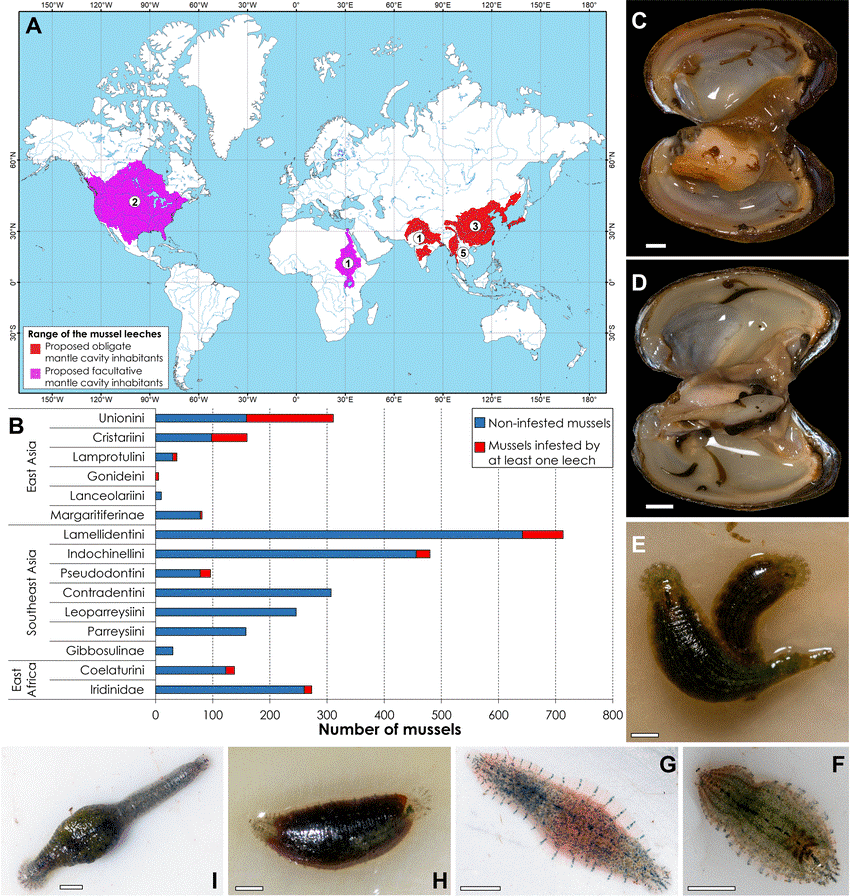Occurrence and Ecology of Leeches in Germany-Living

There will be a summary of the information on leech records (Hirudinea) in the brackish Baltic waters of northeast Germany (Mecklenburg West Pomerania). Observations were done in the Baltic offshore waters, particularly at the Adlergrund/Rnnebank, as well as river estuaries (Stepenitz and Warnow) and lagoons (Darss-Zingst, Stettin). Overall, 33 taxa have likely been defined, including a new Piscicola species. Species of Haemopidae, Glossiphoniidae, and
Up to salinities of 2 PSU, Erpobdellidae may survive in freshwater and oligohaline brackish water; a select few even reached salinities of 3.6 PSU. The only species that can survive in mesohaline waters (here, up to 13 PSU) are those in the family Piscicolidae. During the current investigation, several first records for Germany were achieved in brackish waters.
In the current investigation, many new species for Germany (Piscicola kusznierzi, P. elishebae, and P. Viktoria) were discovered in brackish waters. Soon, several notable observed species (Glossiphonia paludosa, Placobdella crostata, Italobdella Epstein, Haemopis elegans, and Dina apathy) were described. So far, 7 host fish species have been identified.
Overview
The only watery settings were where leeches (Hirudinea) first appeared and underwent more than ten evolution families. However, terrestrial (like the Haemadipsidae family) and marine (such as the Piscicolidae and Ozobranchidae) species have evolved from that point on.
Leeches living in the Baltic Sea’s brackish waters are very briefly mentioned in a minimal number of literary works (such as Sander 1953, Bielecki 1995, and Koli 1960). Recent years have seen a disproportionately high number of records being set in the brackish waters off northern Germany. 458 occurrences were examined, of which 433 were localized in inner coastal waters, and 25 originated offshore. The Leibniz Institute for Baltic Sea Research made the majority of these observations.
Occurrence in Germany
The occurrence of leeches within the previous 20 years was investigated in all marine and brackish water-influenced areas along the coastline of the Federal State Mecklenburg-West Pomerania in North-East Germany.
A few extra data from the Baltic Sea off Poland, Denmark, and the German EEZ were also considered.
About 350 kilometres make up Mecklenburg West Pomerania’s exterior coastline. More than 1358 km of the inner coastal waters are covered (Winker et al. 2007). In the current study, we take into account the estuaries of the Rivers Stepenitz and Warnow, as well as the lagoons in the cities of Greifswald, Stettin, and Darss-Zingst, as well as the offshore region at Adlergrund/Rnnebank.
Table 1. lists several abiotic characteristics of the aquatic bodies under consideration, such as water depth and salinity.
Some significant German inner coastal waters’ relevant parameters (based on Winkler et al. 2007 and IOW)
| Water Bodies | Area in Km2 | Maximum depth in m | Salinity (PSU) |
| Estuary of Lake Dassow / Stepenitz | 8 km2 | 2-3 (4,5) | 0,5-12 |
| (Along with Salzhaff) Wismar Lagoon | 168,9km2 | 6 (121,0) | 11 (8-24) |
| Warnow estuary | 12,5 km2 | 4(11) | 0,5-18 |
| Darss-Zingst Bay | 196,8 | 2 (12) | 0,5-12 |
| Strelasund | 64,6 | 3,9 (16) | 7,5 (7-12) |
| Greifswald lagoon | 510,2 | 5,9 (13,5) | 6-8 |
| Peenstorm | 163,9 | 2,6(16) | 0,5-1,5 |
| Stettin Lagoon | 277,2 | 3,7 (7,8) | 0,5-5 |
The current study includes all information on brackish water leeches in German Baltic Sea waters collected over the past 20 years by Baltic Sea Research (IOW) (IOW-data base, Rödiger 2003, Wittfoth 2011).
Additionally, several documents belonging to colleagues (F. Wolf, A. Berlin, and H. Menzel-Harloff) were utilized.
The first author also checked the material from a few collections and museums, including the German Oceanographic Museum Stralsund, the Zoological Museum Hamburg, and the Zoological Collection of the University of Greifswald.
The salinity ranges are categorized in the following sentences using the Venice system:
0,5 psu for freshwater (limnic)
0 to 30 psu of oligohaline in brackish water (mesohaline) Mesohaline, 0.5 to 5 psu Polyhaline, 5 – 18 PSU, 18 – 30 PSU
> 30 psu for marine (euhaline)
Verdict
The following paragraphs will quickly present all water bodies having leech records.
River Stepenitz and River Warnow Estuaries
Numerous estuaries may be found along the German Baltic coast. The Darss-Zingst Lagoon and the Stettin Lagoon, respectively, these rivers will be taken into consideration.
Lowland River Stepenitz empties into Lake Dassow, an 8 km2 brackish water lake with salinities varying from 0.5 to 12 pm, close to Dassow. The Trave Estuary connects the open Baltic Sea (Lübeck Bay) and the lake. In this estuary, 7 different leech species have been identified. They are all common species that favour the muddy sediments of moving rivers.
Bay of Wismar and Salzhaff
Wismar Bay, including the Salzhaff, has the highest salinities compared to other inner coastal waters. Therefore, the Bay only contains a small number of Piscicolidae species. There are samples in the German Oceanographic Museum in Stralsund that were collected in 1968 and 1971, respectively. Piscicola cf. pojmanskae and Piscicola cf. annae are these. Palm et al. (1999) also documented records of Piscicola sp. parasitizing Zoarces viviparus, Pungitius pundits, Platichthys flesus, and Scophthalmus maximus from the Salzhaff. Most likely, it is not P. geometry, as the authors claim.
Lake Darss-Zingst
A chain of four lagoons spans between the peninsula Fischland-Darss-Zingst and the mainland. The salinity rises from 0.5 PSU in the westernmost region to 10-12 psu at the easternmost point where it meets the open sea. Nearly freshwater conditions continue to exist at the mouths of two inflowing rivers (the Recknitz and the Barthe). There were 16 different species in total. While there are nine species in the Piscicolidae family, there have also been sporadic sightings of a few species of Glossiphoniidae and Erpobdellidae in the lagoon’s innermost (oligohaline) regions. Particularly remarkable are the Piscicola species.

